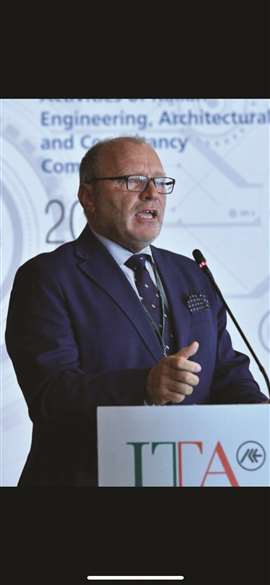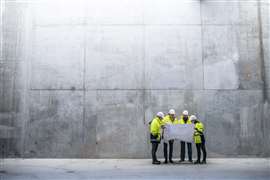Read this article in Français Deutsch Italiano Português Español
How can we address the skills shortage in Europe?
23 February 2024
A shortage of skilled construction workers across Europe is acting as a barrier to growth. Catrin Jones asks some of Europe’s largest construction trade associations what can be done about it
An unprecedented labour shortage for construction workers across Europe is jeopardising growth across the continent, forcing contractors, trade associations and national governments to wrestle with difficult questions about the industry’s image, culture and purpose.
At the Brussels headquarters of the European Federation of Engineering Consultancy Associations (EFCA), which represents more than 10,000 engineering and architectural companies across Europe, federation board member, Roberto Carpaneto, says that after the wars in Ukraine and Gaza, high energy costs and inflation, a shortage of workers is one of the key issues holding the economy back.
 The general economy in the EU performed sufficiently well in 2022 (Photo: AdobeStock)
The general economy in the EU performed sufficiently well in 2022 (Photo: AdobeStock)
“This is very clear in our sector,” he says, pointing to figures from the European Labour Authority. “In the construction and service sector, labour shortages were reported to be a limit to growth in 31% of the cases in the European Union (EU) last year.”
As a result, Carpaneto says, EFCA members are being forced to increase wages for architects and engineers as they compete with rivals in a demanding labour market. “Most of our engineering and consulting companies are suffering from this,” he says. “Competition [for staff] between companies and the extended number of unfilled vacancies for new engineers and architects was one of the most difficult issues for HR offices in our companies.”
“It is not just a question of quantity, but the required skills were also an issue,” he adds. “Our companies are making continuous efforts to train and help new employees well above the [levels demanded by] simple organic growth because of the significant turnover in this demanding period.”
Why is there a shortage of construction workers in Europe?
Although firms may be struggling to attract relatively high-wage, high-status construction workers such as engineers and architects, those looking for blue collar construction workers such as crane operators, carpenters, welders and site managers, say the situation is far worse.
 Roberto Carpaneto, EFCA (Photo: EFCA)
Roberto Carpaneto, EFCA (Photo: EFCA)
Across Germany, France and the United Kingdom especially, bosses have for years been struggling with the fact that there are not enough suitably skilled construction workers to fill the number of jobs – a situation which intensified during the post-pandemic construction boom.
In Germany, despite the country’s worse property crisis in decades and the economy falling into recession last year, Marius Graf, consultant for EU economic and social policy at German construction industry association BauIndustrie, says that the shortage is still keenly felt.
“In 2023, there were around 52,000 vacancies in the sector,” he says. “However, there are numerous unreported vacancies, so the real figure is estimated to be much higher.”
To plug the gap, the European industry has traditionally relied on a steady stream of semi-skilled or unskilled workers from Africa, the Middle East and even South America.
“Many countries, including Western Europe and Europe in general, rely on immigration to maintain their workforce. Although it can be a sensitive topic politically, it is a recognised and necessary aspect of the workforce mix,” says Riccardo Viaggi, secretary general at the Committee for European Construction Equipment (CECE). “However, once these people learn the language, they tend to leave the sector.”
“The next step is to ensure that people don’t just see construction as a temporary job that anyone can do,” he adds.
Léna Guyon, policy officer of social affairs at the European Construction Industry Federation (FIEC), says that new technology can help construction to shed its image as a low-skill, low status occupation of long hours and hard physical labour.
“By embracing digitalisation and the green transition, construction work can become more attractive to people. Working with new tools and technologies can also make the job easier and more efficient,” she says.
New tools and technologies
Instead, she says, the industry should market itself more as an agent of environmental and social change.
“Nowadays,” she says, “we can observe a significant shift in people’s priorities when it comes to their career choices. More and more individuals are seeking jobs that are meaningful and have a positive impact on the environment and society. In this regard, the construction industry has the potential to be a great contributor.”
 Léna Guyon, FIEC (Photo: FIEC)
Léna Guyon, FIEC (Photo: FIEC)
Caroline Gumble, CEO of the UK-based Chartered Institute of Building, agrees. “People need to recognise the industry as a profession, not as a job,” she says. “You can rapidly progress your career in this industry, probably faster than in most others.”
Like many, Gumble says that one of the biggest challenges for resolving the skills crisis, is to work to achieve a lasting change in the industry culture in order to make it more welcoming, both to women and to those from different ethnic backgrounds.
“It isn’t about tick boxes. There must be a real shift in making people feel part of the industry and feel that they’re welcomed and encouraged,” she says. “It’s going to take lots of generations to have an industry that replicates the communities that the industry is part of.”
“What we need to do is showcase the individuals who are already being successful in the industry,” she adds. “We spend a lot of time trying to do that because it’s the old saying – ‘If you can see yourself, then you can become yourself’. It’s really important to do that.
CECE’s Viaggi agrees. “If we want workers to stay, we need to address the issue of diversity and inclusion in the workforce. It’s not enough to just improve the industry’s attractiveness and hope that people will come. We have to be much more proactive in promoting the sector and creating a welcoming environment for all.”
One of the key ways to do this, Guyon says, is to overhaul the way that construction is taught, both in schools, universities and in specialist training centres.
“There is a need for not only companies but also the government and educational system to work together to improve training centres,” she says. “Teachers should also be trained to use new technologies to ensure that students receive the proper training. There should be no mismatch between the training and practical application of skills.”
STAY CONNECTED


Receive the information you need when you need it through our world-leading magazines, newsletters and daily briefings.
CONNECT WITH THE TEAM











